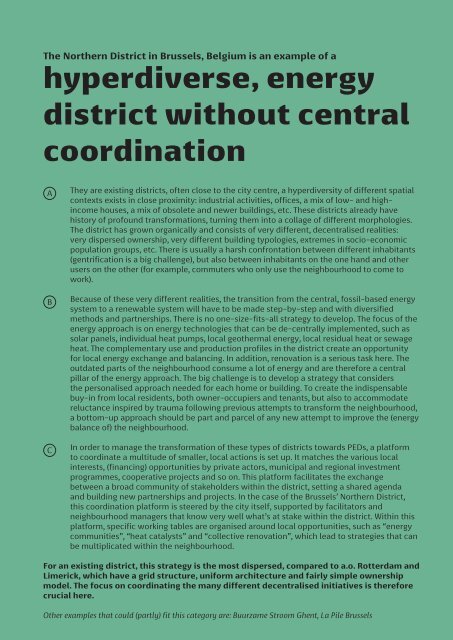Cities4PEDs Atlas_November 2021.pdf
Atlas - From 7 case interviews to recurring strategies and PED relevant aspects
Atlas - From 7 case interviews to recurring strategies and PED relevant aspects
- No tags were found...
You also want an ePaper? Increase the reach of your titles
YUMPU automatically turns print PDFs into web optimized ePapers that Google loves.
The Northern District in Brussels, Belgium is an example of a<br />
hyperdiverse, energy<br />
district without central<br />
coordination<br />
A<br />
B<br />
C<br />
They are existing districts, often close to the city centre, a hyperdiversity of different spatial<br />
contexts exists in close proximity: industrial activities, offices, a mix of low- and highincome<br />
houses, a mix of obsolete and newer buildings, etc. These districts already have<br />
history of profound transformations, turning them into a collage of different morphologies.<br />
The district has grown organically and consists of very different, decentralised realities:<br />
very dispersed ownership, very different building typologies, extremes in socio-economic<br />
population groups, etc. There is usually a harsh confrontation between different inhabitants<br />
(gentrification is a big challenge), but also between inhabitants on the one hand and other<br />
users on the other (for example, commuters who only use the neighbourhood to come to<br />
work).<br />
Because of these very different realities, the transition from the central, fossil-based energy<br />
system to a renewable system will have to be made step-by-step and with diversified<br />
methods and partnerships. There is no one-size-fits-all strategy to develop. The focus of the<br />
energy approach is on energy technologies that can be de-centrally implemented, such as<br />
solar panels, individual heat pumps, local geothermal energy, local residual heat or sewage<br />
heat. The complementary use and production profiles in the district create an opportunity<br />
for local energy exchange and balancing. In addition, renovation is a serious task here. The<br />
outdated parts of the neighbourhood consume a lot of energy and are therefore a central<br />
pillar of the energy approach. The big challenge is to develop a strategy that considers<br />
the personalised approach needed for each home or building. To create the indispensable<br />
buy-in from local residents, both owner-occupiers and tenants, but also to accommodate<br />
reluctance inspired by trauma following previous attempts to transform the neighbourhood,<br />
a bottom-up approach should be part and parcel of any new attempt to improve the (energy<br />
balance of) the neighbourhood.<br />
In order to manage the transformation of these types of districts towards PEDs, a platform<br />
to coordinate a multitude of smaller, local actions is set up. It matches the various local<br />
interests, (financing) opportunities by private actors, municipal and regional investment<br />
programmes, cooperative projects and so on. This platform facilitates the exchange<br />
between a broad community of stakeholders within the district, setting a shared agenda<br />
and building new partnerships and projects. In the case of the Brussels’ Northern District,<br />
this coordination platform is steered by the city itself, supported by facilitators and<br />
neighbourhood managers that know very well what’s at stake within the district. Within this<br />
platform, specific working tables are organised around local opportunities, such as “energy<br />
communities”, “heat catalysts” and “collective renovation”, which lead to strategies that can<br />
be multiplicated within the neighbourhood.<br />
Working document<br />
For an existing district, this strategy is the most dispersed, compared to a.o. Rotterdam and<br />
Limerick, which have a grid structure, uniform architecture and fairly simple ownership<br />
model. The focus on coordinating the many different decentralised initiatives is therefore<br />
crucial here.<br />
Other examples that could (partly) fit this category are: Buurzame Stroom Ghent, La Pile Brussels<br />
21


















